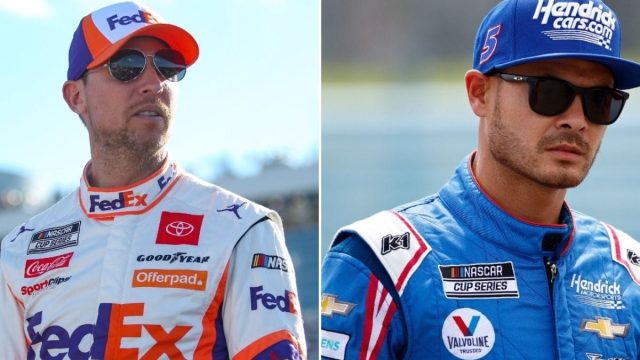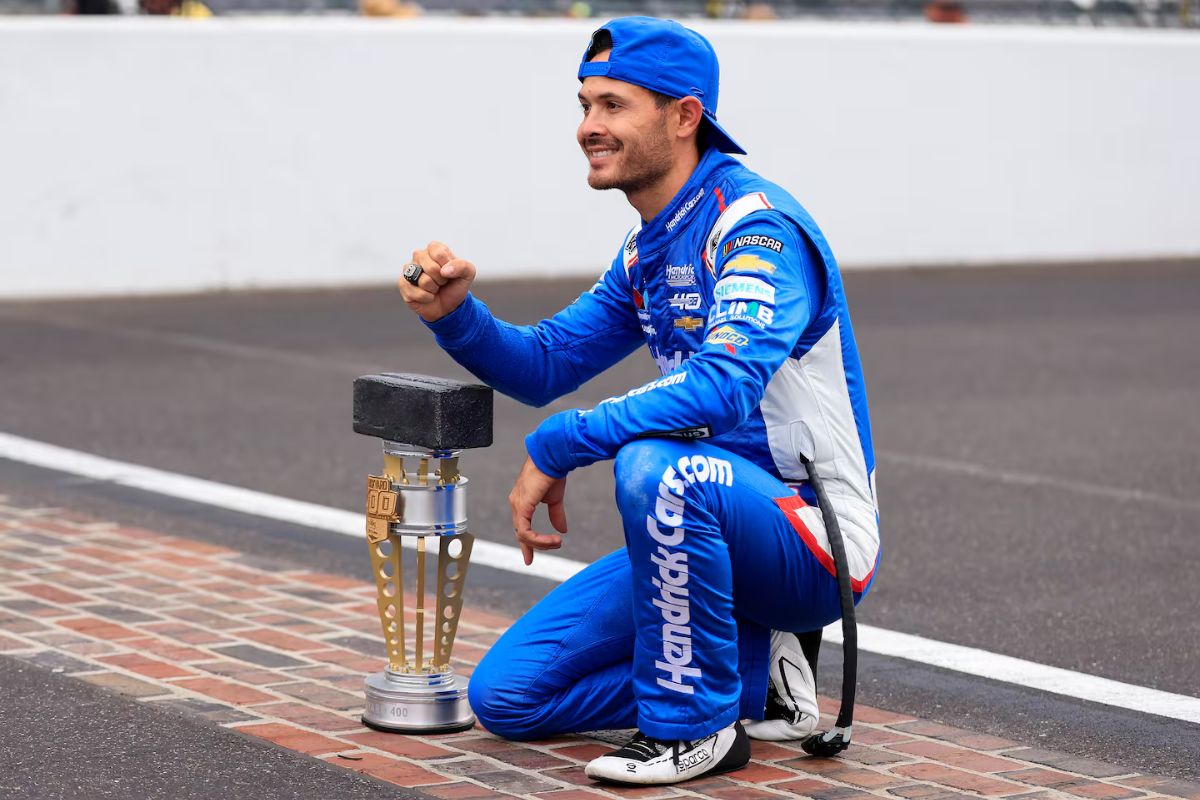Denny Hamlin on Kyle Larson’s Indy Controversial Win: The recent developments regarding Kyle Larson‘s Indianapolis victory have stirred considerable discussion, particularly in view of Denny Hamlin‘s release of extensive SMT data. This analysis not only clears Larson of accusations related to the restart but also highlights the intricate dynamics of NASCAR racing, especially the significance of track positioning. However, Hamlin’s insights extend beyond Larson’s actions, raising questions about NASCAR’s officiating and the implications of favoritism in the sport.
Key Highlights
- Denny Hamlin provided SMT data affirming Kyle Larson did not jump the restart, supporting his legitimacy in the race.
- Hamlin emphasized the strategic advantage of Larson’s track position on the inside lane at Indianapolis.
- The analysis indicated that Larson’s grip and momentum would have allowed him to overtake regardless of restart timing.
- Hamlin criticized NASCAR’s late caution decision, raising questions about fairness and consistency in officiating.
Kyle Larson’s Controversial Win at Brickyard 400
Kyle Larson’s recent victory at Indianapolis sparked considerable controversy, as allegations of favoritism and questions about the legitimacy of his win quickly overshadowed his achievement. The race, a hallmark event in NASCAR, was blemished by criticisms that suggested Larson benefited from preferential treatment, a narrative that emerged almost immediately after the checkered flag was waved.
Critics, including seasoned veterans and fervent fans, voiced their discontent, citing a perceived inconsistency in NASCAR’s officiating and race regulations. These allegations painted Larson as a ‘golden boy‘ of the sport, suggesting that his success was less a result of skill and more a product of advantageous circumstances. This narrative, however, ignored the rigorous preparation and talent that Larson has consistently exhibited throughout his career.
The timing of his victory, coupled with a controversial restart that had considerable implications, only amplified the skepticism surrounding his win. As discussions raged across social media platforms and sports forums, the focus shifted from Larson’s on-track skill to the legitimacy of his accolades.
Denny Hamlin’s Views on Indianapolis Restart
Amid the swirling controversy surrounding the restart at Indianapolis, Denny Hamlin emerged as a voice of reason, offering a detailed analysis of the situation that challenged prevailing narratives about Kyle Larson’s actions.
The incident ignited intense debate after Larson seemingly jumped the restart following Brad Keselowski’s pit stop due to fuel issues. However, Hamlin’s insights, shared on his podcast, suggest a more subtle understanding of the restart dynamics.
Utilizing SMT data, Hamlin contended that Larson did not, in fact, jump the start. He pointed out that both Larson and the driver he was competing against, Ryan Blaney, accelerated simultaneously.
Hamlin elaborated on Larson’s tactical positioning on the inside lane, which inherently provided him with a competitive edge. Through this careful analysis, Hamlin demonstrated that Larson’s incremental acceleration—albeit slight—allowed him to maintain an advantage as they engaged.
“He went and gassed it up to get even with the 12 right away. Then he backed off, then he rolled a little bit of speed. When I say a little bit, it’s like a mile per hour the entire time he just kept creeping, creeping, creeping, and then they fired at the same time. And then what happened was since they fired at the same time, Kyle’s got that one-mile-per-hour advantage the whole time.” – (hamlin)
Did Kyle Larson jump the restart? pic.twitter.com/JYmHEjoOEr
— Mr Matthew CFB (@MrMatthew_CFB) July 21, 2024
Hamlin’s Take on Track Position Advantage
Analyzing the vital importance of track position, Denny Hamlin emphasized that Larson’s advantage on the bottom lane at Indianapolis was essential, rendering any debate over the restart largely irrelevant. The unique configuration of the Indianapolis Motor Speedway amplifies the significance of positioning, particularly regarding the bottom lane, which offers a distinct edge in acceleration and cornering.
Hamlin articulated that even if Ryan Blaney had entered Turn 1 ahead of Larson, the latter’s superior grip and momentum on the bottom lane would have allowed him to overtake Blaney almost immediately. This inherent advantage is not merely a matter of preference but a definitive factor that shapes race outcomes at this particular venue.
When Larson secured the bottom lane, it effectively sealed his fate as the frontrunner, a sentiment echoed by Blaney’s frustrated radio communications.
“There’s no way they should’ve let that go green. That’s ridiculous. They just GAVE it to him (Kyle Larson). It’s f*cking over, I’m on the top. I ain’t gonna win from the top. Gave it to f*cking golden boy. Son of a b*tch.” – (Blaney)
Denny Hamlin Criticizes NASCAR on Late Caution
Following the intense discussions surrounding track position, Denny Hamlin’s frustration with NASCAR’s handling of the late caution at Indianapolis has sparked considerable debate within the racing community. His discontent was particularly directed at the timing of the caution flag following Ryan Preece’s crash on the final lap. As Preece’s car remained immobilized on the track, NASCAR’s decision to wait until after Kyle Larson crossed the finish line to display the yellow flag raised eyebrows among competitors and fans in a similar manner.
Hamlin was not alone in his criticism; fellow driver Brad Keselowski echoed comparable sentiments, highlighting the inconsistency in caution calls. This incident has prompted a closer look at NASCAR’s decision-making processes during critical moments in races.
“Hahahaha, that’s a caution any other week.” – (Keselowski)
Elton Sawyer’s clarification emphasized the challenges faced by officials in such scenarios. The fallout from this decision serves as a reminder of the fine line NASCAR must tread in maintaining fairness and consistency, especially as drivers like Hamlin seek clarity in the rules governing their sport.
“We did everything we possibly could. We kept an eye on the 41. He got turned around. He was really giving a solid effort and once he came to a stop and we could tell that he had, I think, a flat left-rear tire he wasn’t going to move. We’d already taken the white, we just couldn’t run by there again. So it was unfortunate, but it was the right call.” – (Sawyer)
Hamlin Questions NASCAR’s Decision and Favoritism
Denny Hamlin’s pointed criticism of NASCAR’s decision-making raises questions about potential favoritism in the sport, particularly regarding the timing of the caution that ultimately benefited Kyle Larson. Observing from his bus, Hamlin was convinced that a caution was imminent when he witnessed a competitor’s car stop on the track. He expressed frustration over what he perceived as a failure to act swiftly, stating,
“I was like… This is going to be a caution. There’s a caution. Because he stopped. […] And Elton Sawyer says, ‘Well, by the time that we saw that the ’40-one was not able to move, we had already crossed the start/finish line.’ Ugh wrong. That’s not true.” – (hamlin)
"They had roughly 8 seconds to make a call there and they didn't." ⏳ pic.twitter.com/Y9qSnreKsl
— Dirty Mo Media (@DirtyMoMedia) July 22, 2024
The perceived delay in NASCAR’s decision-making, with only eight moments to react. The assertion from NASCAR’s Elton Sawyer that they missed the opportunity for a timely caution. A pattern of questionable calls that Hamlin believes indicate favoritism.
“Some of the calls I thought were just super questionable when it comes to whether they did the caution in the end or not.” – (hamlin)
Hamlin’s comments highlight a growing concern among drivers regarding the integrity of race officiating. By drawing attention to specific instances where decisions appear inconsistent, he invites scrutiny of NASCAR’s processes and accountability.
News in Brief: Denny Hamlin on Kyle Larson’s Indy Controversial Win
The resolution of the controversy surrounding Kyle Larson’s Indianapolis victory emphasizes the significance of data analysis in understanding NASCAR’s intricate dynamics. Denny Hamlin’s examination of the SMT data not only clarifies Larson’s restart strategy but also highlights the critical role of track position in race outcomes.
As discussions about officiating and race strategy continue, the insights provided by this analysis will foster a deeper appreciation for the complexities inherent in motorsports competition.
ALSO READ: Kyle Larson Aiming for the 2025 Indy 500 Run: “Obviously, I’d Love to Do It”



